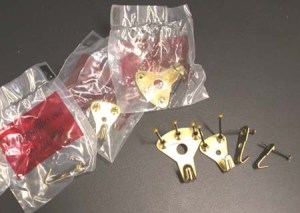Things in my personal tool box:
A tool belt–absolutely necessary when hanging a show! Plus, you feel boss walking around in it.
Hammer–goes without saying.*

Nails of various sizes–I have three different sized nails for the various sized work. I also have sets of picture hangers; the single nail set usually does fine for most hangings, but if the piece is overly large and heavy, I recommend two three-nail hangers. *
Sandpaper and fast drying drywall–of course, this depends on your wall. Ours is a matte finish, with “sheep’s wool” benjamin moore paint. The sandpaper and drywall are to, of course, fill in the holes left by nails.
Yellow Chalk–useful for marking where the nail will go. Wipes off easily, and a light coat of paint will cover it’s mark better than a pencil mark.*
Masking Tape–I use this to mark the spacing between 2-d works. Comes off easily without marring the wall.*
Tape Measure–Also, goes without saying. I have three tape measurers in the gallery–one that lives in my tool belt, one that lives in my tool box, and one that lives on the desk for customers’ use. Customers use tape measurers to personally measure pieces they are interested in purchasing.*
Picture Wire and Eyelet Hooks–not every artist understands how necessary it is to properly wire their canvas works. You can hang a canvas on two evenly hung nails, but wire adds security to the piece, especially if you have busy receptions. Nothing worse than a painting “jumping” off the wall in a crowded room. **
–Pieces that have sawtooth hangers are NOTORIOUS for “jumping off” walls, particularly if you’re hanging another piece next to them. If your artist absolutely cannot do without this evil device, then do all your placement & measurements for the pieces, and REMOVE the work before hammering next to it. You don’t want to damage someone’s work or someone else’s future investment!
Level–Absolutely necessary. Level the work after it’s hung, BEFORE setting the next piece; an unlevel painting can throw off your measurements by a couple of inches, which makes for a visually unsettling display. Level after hanging each piece, before measuring for the next piece, and re-level after getting everything hung.*
OTHER NEEDED ITEMS: Three different ladders–the step ladder, the six footer a-frame, and the 10 footer a-frame ladder. Additional bulbs for your light fixtures, soft cloth (I use rags made from an old sweat shirt)*, windex, paper towels, and lint rollers. A screwdriver–I have one that is both phillips & flat head in one. Screws of various sizes. Electric drill (luxury item!). Push pins, and binder clips. A razor blade and straight edge are important as well. We have a hand truck (luxury item!) for heavy sculptures and for easily moving pedestals.
*Denotes items suggested for tool belts.
**Tutorial on wiring canvas coming soon.
*Ms. Wakefield admits levels are often her impulse purchase of choice. She cannot tell you how many pocket levels she owns.

